
The Pomodoro Technique is a simple and effective way to work more efficiently. It’s easy to see how it would be beneficial for anyone who struggles with distractions or procrastination during the day. This post will explain how this time management system works, what you need in order to implement it, and why so many people love it.
The Pomodoro Technique is a time management system developed by Francesco Cirillo in the late 1980s. It encourages you to work with your own natural rhythm, rather than against it. You can use this technique whether you need help getting started or have trouble staying focused on a project for long periods of time. With this method, users break their day into 25-minute chunks separated, by five-minute breaks.
The first step is to identify what you need to work on. This might be a task that needs to get done in several short sprints, or it could just be a project you’re working on – but either way, this will give your brain something specific and finite to focus on. Next up: Set a timer for 25 minutes, select a task to complete, and start working on that.
If you’re having trouble focusing or getting started with your work, try setting up specific goals first: Make sure that you have the time set aside just for this activity (and nothing else) every day; this will help keep distractions out of the picture. You can even try working on the Pomodoro Technique with a friend, or setting up “office hours” to work together.
This technique is most effective when it’s combined with things like task lists and progress bars, but you can add as much structure (or as little) as you need, to make it fit your needs and preferences perfectly. You might find that doing a weekly or monthly review of your progress and goals is a great way to keep yourself on track – and if you’re having trouble staying motivated, try giving yourself rewards for hitting milestones along the way!
There are lots of different ways that you can use this technique to work more efficiently and get everything done; hopefully, it’s something that you can implement into your own life. Whether you’re using it to get work done, or just trying to focus on fitness and weight loss goals, this is a great way to keep yourself motivated and productive with any activity.

It encourages users to work with their natural rhythm rather than against it! Everyone has different levels of energy throughout the day – it’s crucial that we honour this instead of forcing ourselves through various tasks, regardless of our focus level. This method also helps prevent us from underestimating how much time certain projects actually require – an issue many people struggle with when they’re first starting something new or tackling a difficult project for the first time.
Research has shown that procrastination is not truly about laziness or lacking self-control. The root of the problem is that we’re human beings, not robots. We all have different starting points and need to honor our own natural rhythms.
The Pomodoro Technique makes it easy for anyone to just get started on something – no matter how difficult or daunting a task might seem at first. Studies have also show an effective way to break out of the avoidance cycle: Take a small first step that will make your task seem less intimidating.
For example, if you’re trying to clean your apartment, begin by starting a load of laundry or organizing one small area. By tackling something that doesn’t seem so overwhelming right away, you can build momentum and avoid the urge to procrastinate. It allows you to take on the project that’s in front of you, rather than feeling overwhelmed and stressed out by the big picture. Don’t think about the big picture – focus on the steps one at a time.
You likely know what it’s like to work on something you’re really focused on for a few hours, only to be interrupted and struggle to get back into the same state of flow. However, the abundance of information flooding through emails, team chats, and social media demand more attention than ever.

The Pomodoro Technique helps you improve your ability to work with distractions, rather than against them. It’s important to remember that distraction is not the problem – it’s how we deal with it! When something pulls our attention away from a task, there are two options: Resist or embrace.
The trick here is knowing when and where to use each one. The goal isn’t to never get distracted – the key is finding balance between giving yourself breaks when you need them, but also sticking through difficult tasks until completion. Just as long as all of these steps are taken in order of priority (i.e., don’t check Facebook if writing emails for your boss).
When planning out our projects, we tend to underestimate the time needed to complete them, even if we know similar tasks have taken longer in the past. The Pomodoro Technique encourages us to build awareness of how we’re spending our time, so that we don’t underestimate or overestimate the amount of energy and focus required.
This helps prevent us from getting stuck in perfectionistic loops, where an obsessive need for excellence can actually decrease productivity instead. This is because most tasks require more than one sprint – when you get interrupted after only 25 minutes, it’s easy to feel like something isn’t finished when really, it just needs a little extra TLC before being set aside again until tomorrow.
It allows people who are often distracted by their environment (like those with Attention Deficit Disorder) to work on what they want without feeling out-of-sorts all day long. So if you’ve got something important to do, the Pomodoro Technique is an easy way to build better habits and improve your focus – so you can be more productive at work without feeling overwhelmed.

The best part about trying something new is that there are no rules to follow. The last thing you want to do when starting out with the Pomodoro Technique is feel like you have a ton of restrictions or guidelines. Instead, think of it as an opportunity for experimentation and play around until you find what works best for your unique situation. However, here are some quick tips to get started:
It’s important not to lose track of time, but also to remember not to work for more than 25 minutes without taking a break (even if you’re in the middle of something). This is especially true when starting out with this process – it’s hard enough avoiding procrastination as it is, so just stick with five-minute increments until your body has gotten used to sitting still for longer periods of time again. Once you’ve going through an entire Pomodoro, it’s okay to take a slightly longer break (around 15-30 minutes).
So give yourself permission not to be perfect! The key is finding your own balance between giving yourself breaks when you need them but also sticking through difficult tasks until completion. And remember that sometimes “perfectionism” can actually decrease productivity instead – so don’t feel bad if something isn’t quite right or needs some TLC before being set aside again soon.
While this technique may seem silly at first, millions of people swear by the life-changing power behind it, and how much more productive their workdays become as a result. Try getting started with one task today and see what kind of difference 25 minutes makes for you!
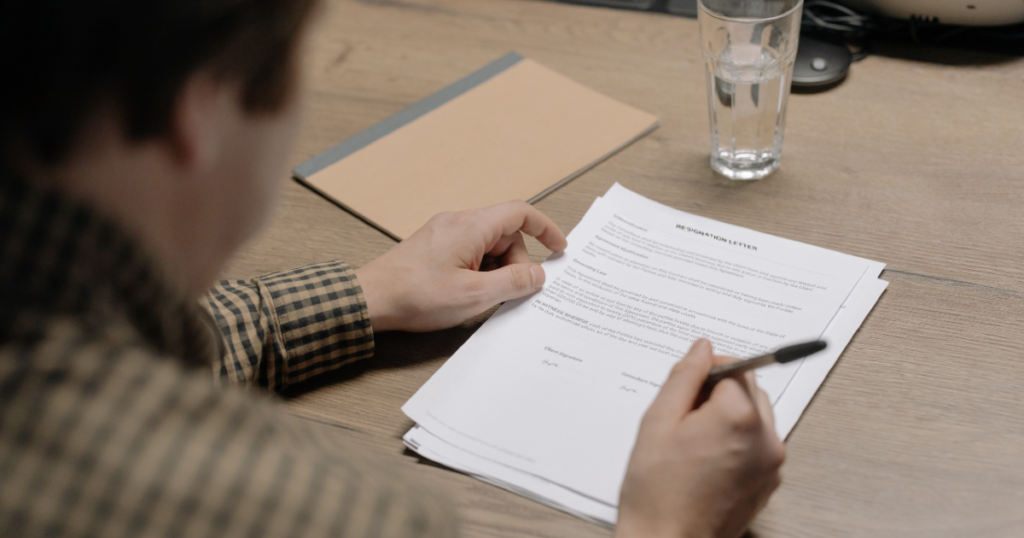
It’s never easy to resign from your current position, but it can be made easier with a well-written resignation letter. This article provides guidance on how to write an effective resignation letter that you and your employer will both appreciate.
The first thing you need to do is decide why you’re writing the letter. Is it for work purposes, or personal reasons? Sometimes there can be a difference in what kind of tone and language should be used, depending on your reason for writing the resignation letter. For example, if this is due to another job offer that may make staying at your current company impossible, then using some formal wording will probably help with convincing them that this change was inevitable no matter how much they wished otherwise.
In addition to being professional, referring back to past moments shared together could also show how much working here has meant over time, while showing respect toward those who have helped you grow as an individual within their organisation. On the other hand, sometimes people write resignation letters to leave for personal reasons, such as moving to a different country or a family emergency. In this case, showing your gratitude toward the company and people who have helped you is still important. However, it should be done in a more casual tone that communicates how much these past few years meant to you, while also communicating their excitement about what’s next without seeming negative in any way.
Next comes choosing an appropriate format based on whether you’re writing the letter for professional purposes or not. If this resignation letter will be used for work purposes then there may need to be additional documentation included with it depending on why you’re leaving and when your final day of employment will be. This includes things like official proof that they were notified within the legally required time frame and any paperwork that they might need to submit to the government as a result. In addition, there will be some additional communication with your boss or HR department about when exactly you’ll show up for work on your last day so these can all come together in one easy package without anybody being confused.
Once you know what kind of format is best then it becomes much easier to write the letter itself. Again, if this resignation letter is for professional purposes then keep things brief and formal while also conveying gratitude toward those who have helped shape who you are today. These types of letters often don’t get too personal unless the relationship between employer and employee has been very strong over many years, so try to keep it professional and emotional. On the other hand, if this is a personal letter then you can take more time detailing what has made working there so special along with expressing how excited they are about their next step in life. Keep things brief but heartfelt while also including any gratitude toward those who have helped them on their journey over the years.
It’s important to remember to proofread before sending. It might seem like an obvious point, but many people send out their resignation letters quickly without thinking twice when really, these should be carefully crafted pieces of writing that express everything properly from start to finish. Once you’re happy with your letter then save it as a draft or directly send it off depending on whether or not others will need to review it first. Resignation letters don’t have to be difficult or stressful, but they can make a big difference in how your former employer feels about you after such an important event like this one.

Finally, the date of your last day should be written on all documents that you send with this letter. Your final paycheck stub for example might need to include information about when exactly it was given out so using a formal resignation letter as an official notification will help make everything clear for everyone involved while also being considerate toward their own needs and legal requirements.
Here are some examples of what a resignation letter might look like for a professional reason.
It has been my privilege to work at [Company Name] since [date]. I am stepping down from my position with your company in order to pursue other opportunities. I have really enjoyed my time here and I am leaving with great memories of the things that we’ve all accomplished together. I want to say thank you to everyone who helped me grow as an individual, especially [name(s)].
Please accept this letter as my official resignation from your company effective immediately. Enclosed please find proof of termination within the legally required timeframe along with any additional documentation needed by law or business regulations.
Dear Mr./Ms., Please accept this letter as my official resignation from your company effective immediately. Enclosed please find proof of termination within the legally required timeframe along with any additional documentation needed by law or business regulations. Thank you for everything that I have learned here and best wishes to you in the future.
When it comes time to write out your own personal reasons for leaving then try not to state anything controversial since there is no need to get anyone upset over something so important. You might even want to consider asking a friend or someone else you trust for their advice on what kinds of things are appropriate to include in your letter if they have previously written one themselves that was very effective and well-received by others.
Here are some other examples of a resignation letter for personal reasons. It also includes an expression of gratitude toward those who have helped them grow over the years.
I am really sorry to inform you that I will be leaving Company Name in two weeks. Due to personal issues beyond my control, I am no longer able to fulfil the demands of my job, and I believe it is in the company’s best interests if I leave. I would like to express my sincerest apologies for leaving [Company Name], as well as to offer you my best wishes in the future. Please do not hesitate to contact me if you believe there is anything I can do to make the transition go more smoothly. Thank you so much for your patience. Working with you was a pleasure, and I appreciate my time at the firm despite the personal difficulties I am dealing with right now. I hope we will be able to keep in touch, and I am excited to see how [Company Name] develops in the future.
This guide should help with writing out both professional or personal reasons for resigning. If it’s been hard finding the right words when crafting such a significant document then we hope our advice has given you some helpful tips on what information might be appropriate depending on whether others need to review it first before sending off. Good luck!

You’ve been offered a job. Congratulations! But now, you have to turn it down, and the thought of doing so may feel like a punch in the gut. It’s not just about turning down an opportunity – it’s about having to say no to someone who has given you an offer that you’re honoured by. The good news is: You can do this with class, grace, and some simple strategies for turning down a job offer without triggering offense or resentment on either side of the table.
If you’re reading this, chances are that you’ve already been offered the job and have a lot to think about. So let’s get down to it: Here’s how you can turn down an offer with tact!
Be sure of your decision before responding. Don’t be “yes-and” or change your mind later on when emotions fade in light of other offers (or lack thereof). Once you decline, there should be no turning back. This means being certain enough to not beat around the bush or say things like “I’m really flattered by this offer…” If you aren’t 100% positive that taking another position would better serve your career goals, then you should take a deep breath and say no!
Gracefully declining an offer can be done in several different ways: You could respond with a counter-offer of your own, or simply decline the job without offering any alternative ideas. A third option would be to recommend someone else for hire who might better suit their needs (if applicable). Keep in mind that there are many other options than those listed above so feel free to deviate if it suits your situation! The point is: It’s always best not to let emotions cloud your judgement when turning down a request.
While it’s never fun to tell someone “no” (especially if you truly enjoyed the interview process), your goal should be to make yourself feel better about turning down a job offer and not offend other parties involved. This means avoiding being vague when delivering bad news – you don’t have to give in-depth details but be sure that you say something along the lines of: “I’m so grateful for this opportunity; however, I’ve decided to go in another direction at this point.” If there are any concerns with their hiring practices or things that didn’t feel quite right during the process, you can bring those up in a professional manner as well – but be sure to remain diplomatic!

Although there is no one “perfect” way to turn down a job offer, you should always be objective and honest about your specific reason for not accepting the position, saying something like:
Once you’ve turned down an offer, it’s always a good idea to follow up with your contact-especially if they’re someone who might be able to help you out in the future. You want to keep them on your side. So shoot them a quick email thanking them again for their time, and reiterating that no one is better suited than yourself at this point but wishing them well either way. This will leave things on positive terms rather than turning into something negative or awkward.
Thank-you responses are a good way to demonstrate your gratitude for time and effort. For example:
One of the most important things to remember is that your offered job isn’t always going to be a perfect fit for you-no matter how good it looks on paper or in person. That’s why being able to turn down offers gracefully is very important when looking at long-term career prospects. It shows self awareness, confidence, professionalism, pride and discretion which can help support building relationships within the workplace environment from both employer/employee perspectives. The goal should always be getting closer as opposed to moving further apart with each job offer turn-down, so having great communication skills are necessary in order to keep things moving forward.

As a data scientist you’re used to solving complex problems, and writing a resume just happens to be the code you just can’t crack. Luckily for you, we’ve cracked the code, so you don’t need to! Writing the very best data scientist resume is possible with our guide. We cover what to include to help you stand out, and even additional skills to consider learning to become a more sought-after talent.
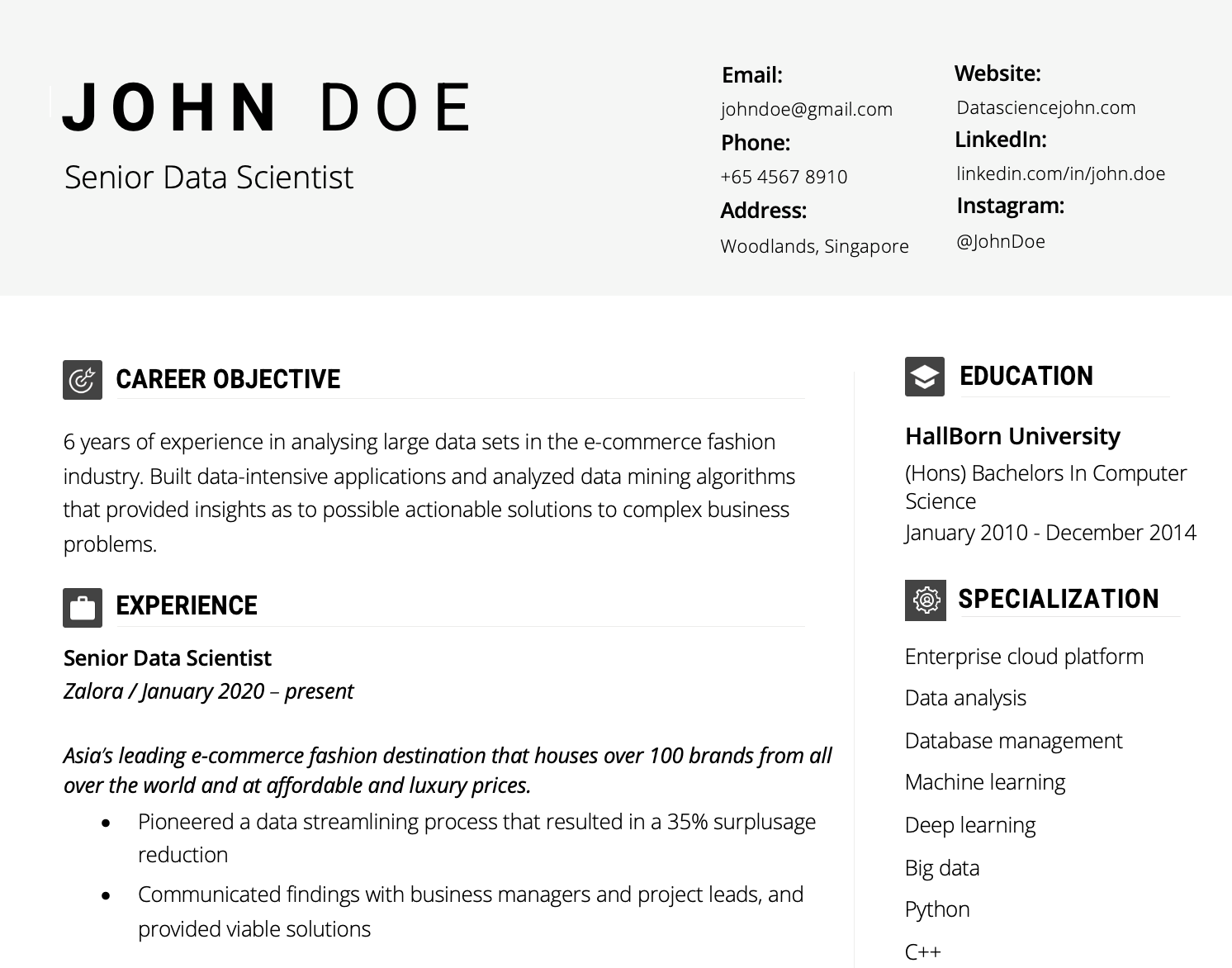
Keep all of the information on one page for a well-received resume. If your career spans further than a decade, you can get away with a two-page resume. Keep in mind that resumes should be concise and targeted.
This is the flow of a resume you should follow:
As for formatting, these are the basics you need to know:
You might be wondering, what’s the point of a summary when a resume is already so short. A summary provides an opportunity to slightly elaborate on your professional background, qualifications and drive behind growing your career in this specific industry. Provide a glimpse into why you love what you do, or why you want to grow and develop skills further.
Example: 6 years of experience in analysing large data sets in the e-commerce fashion industry. Built data-intensive applications and analysed data mining algorithms that provided insights as to possible actionable solutions to complex business problems.
When drafting your work experience portion of your resume, keep two things in mind: Bullet points and specific experience.
1) The Job Description: Formulates and defines systems scope and objectives for complex projects through research and fact-finding combined with an understanding of applicable business systems and industry standards.
2) Your Experience: Strategised systems scope and objectives for three complex projects through research and fact-finding combined with an understanding of applicable business systems and industry standards.
Action words in resumes are adjectives that are used to describe achievements and experiences. It’s a terrific method to get the attention of the hiring manager and highlight your accomplishments.
Words like these are great action words to consider when writing your resume:
Since a resume is short and to the point, here’s what to include and what to leave out.
If you’ve been meaning to up your value as a web developer, there are a handful of certificates you should look into regardless if you’re starting out or a veteran looking to sharpen your skills. Many are offered solely online with great time flexibility to work with your schedule and learning pace.
Here are some certificates worth considering:
Awards are a great reminder of the achievements you’ve accomplished for your company or with your industry.
A cover letter is a terrific complement to any resume because it allows you to go into greater detail about why you’re the best fit for the job. Instead of sending out generic resumes to each potential employer with an open position, a cover letter demonstrates your want to work for the company you’re applying to. The structure of your cover letter matters as much as the content itself.
Make sure the font size and spacing are as easily readable as they are appealing to the eye. When describing your successes and experiences, utilise action words to emphasise your relevant talents to the position you’re wanting to be recruited for. Applying for a different position in the computer science field? Check out the links below:
Need a few more details? Check out our other in-depth guides on writing a resume, CV, and cover letter. All guides are suitable for any profession with tips for careers across the board.

If you have a job interview coming up, it’s important that you know what to ask in order to get the answers that are most relevant for your situation. There are many questions out there that can help you determine if this company is right for you or not. “So, do you have any questions for us?”: Now this is the part of an interview that comes at the end. It’s important to use this list so you cover all your bases and make sure not to forget anything. In this blog post, we’ll cover some of the essential questions to properly prepare yourself when going into an interview.
The more questions you ask about the job, the better. When working in a new place, it’s important to know what is expected of you and where everything is located. You should also have an idea of how your performance will be measured so that there are no misunderstandings later on down the line between yourself and management – or even with co-workers. There are many questions to ask about the job. Some include:
In order to make a wise decision about your future, you need to know what is going on in the present. Understanding how your likely manager will measure success and the company’s priorities is critical to working well together. These questions should be very helpful to understand how your “fit” is with this company.

Having a good rapport with your interviewer is key to getting the job. You can show that you’re interested in them – and they will be more inclined to offer you employment. Here are 12 questions that will help build rapport during an interview:
How much do you know about the company that you might work for? Do you have any idea what their values are or if they even have a specific culture? It’s important to understand the place where you will be working, because it can affect your day-to-day and how much fulfilment and satisfaction you find in your job. These are the questions to ask when interviewing at a company so that you can really get to know them before accepting an offer.

Do you ever wonder what it would be like to work in a different company? One that is more laid back or one that works harder and plays harder? It’s important to know the culture of your company. Culture will determine how productive you are, how happy you are, and if the job is even worth sticking with. Take time to ask these questions about the culture before accepting an offer:
Asking the right questions about training and professional development can help you decide if a new position is the next step in your career success. Consider each job not just as a job, but as an essential step towards your goal of finding long-term satisfaction. Will this position get you closer to achieving that? The following are all questions to ask during an interview for the professional development perspective.
You’ve made it through the interview and you’re on your way out of the door. At this point, the interviewer should know everything they need about you and may very well have some burning questions. These questions can be helpful both in terms of what you do and don’t want to hear, but also in terms of determining the next steps. If they have no questions or concerns then that is a good sign. But before you go, make sure to ask these questions.
It’s not always easy to know what questions you should be asking when interviewing for a new job. The key is understanding the needs and expectations of both yourself and your potential employer. By taking time before the interview to identify which questions are most important, it’ll make it easier during this critical meeting.
We hope that these interview questions have been helpful in getting you started with preparing for an upcoming interview or helped clarify any unanswered points from previous interviews.

It’s a tough question, but it’s one that recruiters are asking frequently in the interview process. The best way to answer this question is with honesty! Employers want you to be passionate about the company and about your career path there. They also want you to have a plan for what you would like to accomplish in five years or less. This article will give tips on how to answer “Where do you see yourself in five years?” during an interview.
One way to answer this question is by mapping out a career path for yourself in the company. This shows that you’re interested in advancement opportunities and willing to invest your time into long-term projects at the organisation. You might say something like, “In five years I see myself working for this specific department as an entry level manager. From there, my goal would be to move up through management until running several different departments across all locations.”
When you answer this question with specific goals, it shows that your values align well with the company. For example, if a company is known to have great work-life balance then say something like “I would love to be able to take off Fridays for family time and stay late on Mondays as needed.” If they’re passionate about giving back through volunteer opportunities or putting in extra hours each week at different events, then mention that you want to find ways in which you can participate.
If there is no one set path for where you see yourself going after five years of employment at one organisation, feel free to share other interests instead. You could also express how much flexibility there is in your career path and how you hope to be able to switch things up as your interests change. Just make sure the answer still shows that you’re interested in working with or for their organisation.
One great way to answer this question is by focusing on why you’re interested in the specific job. You can mention that it fits into your career goals and provides a direct path towards reaching those milestones, but you want to make sure they know how much interest there is for them specifically. This shows that you have done some research about their company as well as some thinking about where you will be after five years of working at such an organisation.
Another way to answer this question is by talking about how you hope to achieve your career goals within five years of employment at their company. You might say something like “The job will help me develop my skills in (insert skill here) and I am confident that after five years, it would also make for a great resume booster.” This shows how working with them specifically fits into the bigger picture as well as provides tangible examples of what is involved in developing each aspect of yourself.

Talking about how you hope to move up when discussing your future career goals is another great way to answer this question. You could say something like “In five years, I see myself in a similar role that also has the potential for more responsibility.” It shows why they should hire you but it also implies that there is room for growth within their company as well. This will make them want to hire you even more because they know your skills and expertise are valuable to the organisation.
Above all, be honest with your answer. Don’t say something that you don’t think is true or will likely not come to fruition simply because the interviewer asks this question! You can also mention how important their company is to your motivation in getting a job and then go into detail about why it’s so meaningful for you.
First, you need to make sure you’re prepared for this question in the interview. Make notes about your career path, short-term and long-term goals. You’ll want to be able to clearly explain where do you see yourself going with your career so that it aligns with what the company is looking for.
Secondly, don’t be afraid to share your passion with the interviewer. They’re interested in hiring someone who is committed and passionate about their career at this company, so let them know that you’re interested.
Third, make sure you’re not only ready to answer this question in an interview but that your career goals align with the company’s growth. If they’re a start-up and want people who can grow along with them there is nothing wrong with saying so.
It’s important to be prepared for this question in an interview so that you stand out among other candidates. You don’t want the hiring manager to know from your answer alone whether or not they should hire you, though! Make sure your resume is up-to-date and highlight some of the skills relevant to this job as well as a few accomplishments that will show them why their company should become part of your future plans too.
Don’t forget that it helps if you’re familiar with where this organisation sees themselves within five years because knowing what direction they’re moving towards can make answering much easier. They might also ask about how current employees see themselves at such a company after several years on board, which shows just how interested they’re in their company. The interviewer is likely looking for someone who will be committed to the company and their future goals.
Make sure that your answer aligns with theirs. If you’re not sure what they’re expecting, take time to research the organisation’s mission statement or organisational values before going into an interview – it can make a huge difference in how successful the interview goes. Remember: honesty pays off in interviews so don’t say something just because you think they want to hear it if it isn’t true.
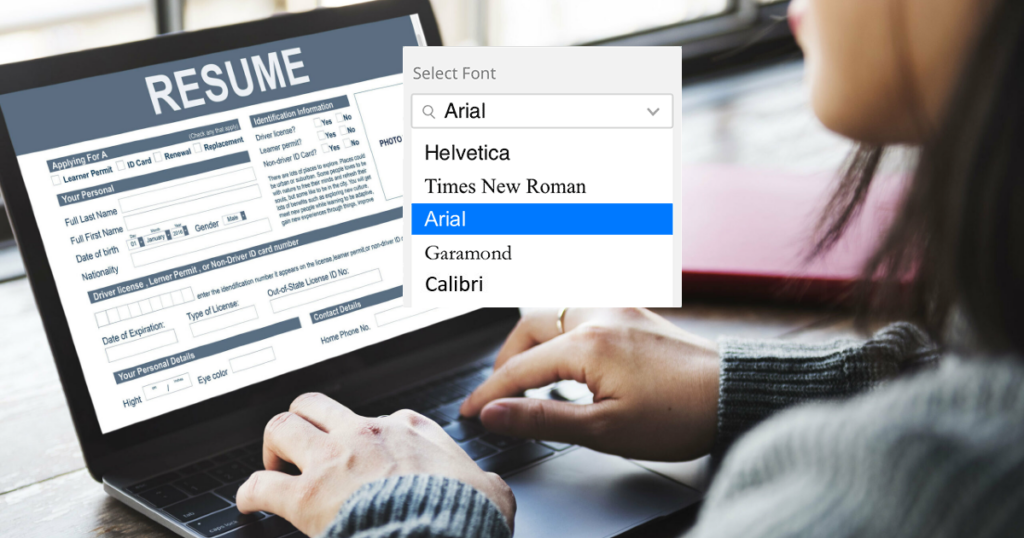
If you’re currently looking for a new job, the first thing that comes to mind is what to wear. But what about your resume? After all, it may be the first impression an employer will get of you. One way in which employers judge resumes is by font size and font type. This article provides information on how to choose the best fonts and sizes for your resume, so that you can increase your chances of getting hired.
There are two main reasons why your resume font matters. First, your resume is a document for humans, not machines. As a job seeker, you want to ensure that the design of your resume will pique the interest of those who read it so they’re thinking about what you can bring to their organisation, rather than being hung up on poor font choices. Use a font that’s both readable and professional-looking.
Another challenge of using different fonts is that HR professionals relying on applicant tracking systems (ATS) cannot read some fonts as well. ATSs are programmed to read resume documents in a certain way to focus on the content and ensure they’re organised accordingly, so resumes need to meet compatibility standards if they’re seeking greater exposure through these programmes.
The best fonts are those that have a classic look and feel, make your resume easy to read, and enhance the design. There’s no “perfect” font because it will be up to the employer’s personal preference. However, there are some excellent fonts you might want to consider:
Now that you have a few guidelines about the traditional fonts and some basic considerations, avoid using any heavily stylised fonts, narrow condensed fonts or light versions of your chosen font. Also know that non-standard or downloaded custom fonts are to be avoided because they can make potential employers think you’re not detail oriented, which may affect whether they hire you for a position. You should avoid these fonts when creating or updating your resume:
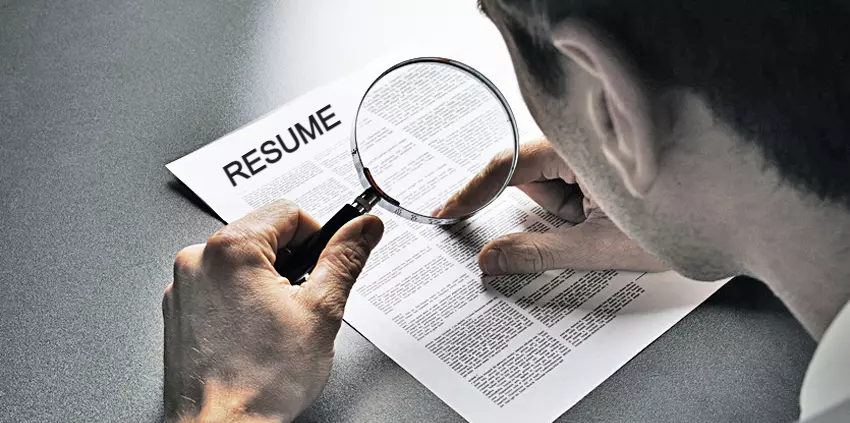
When considering resume font size and length, it’s important to strike a balance. “Too large” of size can result in writing up the entirety of your experience on one page without necessarily having the years of experience to back up that resume length, whereas if you go too small, recruiters may not be able to read your resume and will likely put it in the no pile.
Most experts agree that 12-point font(pt) size is good for resumes since employers can easily scan this type of text quickly without affecting readability. Others recommend using 11-point font size with Arial or Helvetica as the fonts on your resume if you’re applying in corporate settings where conservative
Your name, heading and subheading should all have different font sizes to help create a composition that will catch employers’ attention. The best rule of thumb for these three elements is as follows:
However, these are not the only factors that contribute to a resume’s font size. You should also consider whether your name is in all caps or mixed case. For example, if you have an unusual last name with letters of varying heights (i.e., RyLeeo Chan), then it may be advantageous for your first and last names to be at least 14pt so they will stand apart from each other better on the page. Similarly, there’s no point using 11pt font sizes for subheadings when 12pt would do just as well without sacrificing readability. In general, larger fonts give more authority to written content but make sure that such formatting doesn’t come across as too aggressive or “in-your-face.”
What kinds of fonts fit all these considerations? Put simply, the classics: The fonts that come standard across a range of programmes, and aren’t overly flashy or designed. These fonts became standard because they’re easy on human eyes, and since they’re standard, ATSs are programmed to read them.
Sometimes employers will want really specific information from a candidate’s resume including which schools he attended, what degrees were obtained and where previous places of employment were located; therefore if these items are important to you, then it’s best to use bold font.

It’s typically not a good idea to use underlined text in your resume because the reader might mistake this for links that need clicking, and will be disappointed when they’re only words without any other content attached.
Since recruiters can read resumes quickly, go ahead and make sure all of your resume’s items are easy to scan by using no more than two fonts at one time – with both being serif or sans serif fonts – and keeping headings short but descriptive as possible. Keep them succinct too. If you’re looking for something with fancier typography, try incorporating graphic elements such as icons rather than elaborate headers.
When it comes to picking a font for your resume, there’s really no right or wrong answer. Which one you pick will depend on personal preference and the message you want to get across with your resume.
Consider whether a serif or sans serif font might work better for you. Masculine, modern fonts like Arial and Calibri are likely to be more popular with prospective employers, while more conservative fonts like Times New Roman and Georgia can help make your resume look traditional and trustworthy.
In order to identify the type of font you’re seeing, note if the lines attached to the top of a capital T are short lines or not. If they’re a single straight line across, it’s sans serif. If there are shorter hanging lines, it’s most likely serif. When deciding on the typography for your resume, pick a font which is aesthetically pleasing to you.
While the research might sound daunting, you can create a resume that’s visually appealing by sticking to these classics.
For example, you should use a bold and italic font or emphasise job titles with color to add visual interest. Underlining headings is usually unnecessary since people read underlined text as links to linked content.
In addition to choosing typography that’s readable, your content should be visually pleasing. Use two fonts: one for headings and another for the body copy. More than two font combinations will start to distract the reader.
It’s always important to make sure your resume looks clean and neat. This ensures that you will be able to maintain easy scanning which, in turn, makes it more likely that a recruiter will read the entirety of your skillset. The last thing anyone wants is for their resume to end up at the bottom of a pile because they used an unreadable font; don’t do this inadvertently.
Choosing the right font is a big decision when it comes to your resume. You want to make sure that you’re being clear and concise, but at the same time, you don’t want to lose out on potential opportunities because of unreadable text. To keep things short and sweet – consider using two fonts: One for headings, and another for body copy. In addition, choose typography that will be visually pleasing without distracting from important information in an employer’s eyesight or making them think they have clicked on a link instead of reading text.

Thank you emails are so important. They’re a chance to follow up with the person who met with you and express your gratitude. It’s also an opportunity to leave a positive impression on them before they make any decisions about your candidacy, which is why it’s critical that they be well-written and thoughtful. In this blog post, we will teach you how to write a thank you email after an interview in 3 easy steps: (1) Introduction, (2) body of thank you email, and (3) closing sentence.
In addition to teaching you how to write a thank you email after an interview, we’ve also included several samples from our own archives for your easier reference.
In this step, you will introduce the reader to your email. To avoid sounding too stiff or formal, it is a good idea to include an anecdote that relates back to the interview and highlights something specific about the company’s culture. For example, “I am writing because I wanted to say thank you for taking time out of your busy day yesterday so we could speak one-on-one.”
Another option is including a compliment here such as, “Thank you again for meeting with me last week.” This helps differentiate yourself from other candidates who have not yet followed up after their interviews and shows how much thought went into composing this note beyond just thanking them. If someone interviewed you multiple times before they gave feedback on your candidacy, this is the perfect place to include a follow up on that.
In this step you will share what thank you email typically covers in its body. Generally, these are three points: how much it means to hear back from them (or be offered an interview), why they stand out as a company or employer for you, and finally some specific feedback or request related with something about the process itself – either their questions during the interview or any other details which stood out positively/negatively about meeting with them specifically.
For example, “Thank you so much for taking time off work last week to meet me one-on-one at your office.” Or “I am sorry to hear about the illness that has been going around and I hope you recover soon.”
“I was impressed by your deep understanding of sustainability initiatives during our interview. I am looking for a company where environmental awareness is integrated into all aspects, not just one or two departments which takes it on as an afterthought.”
Or “Thank you again for meeting with me last week. Even though we did not find a fit in terms of roles here at your company, please feel free to reach out if there are any specific positions open anywhere else that might be more suited for my skillset.”
A good way to close this section is asking them once more what they thought about the process overall – whether they enjoyed their time interviewing with you, or if they would be open to meeting for coffee in the future, etc.

Finally, don’t forget a closing sentence. This is where you can provide your contact information one last time and reiterate how grateful you are for taking time out of their day to meet with you. For example, “Thank you again so much for sharing some thoughts on my candidacy with me.” Or “If I have not already done so, please feel free to reach back out anytime as I am always looking for new opportunities elsewhere.”
“I appreciate that we had the opportunity to chat about myself and what skillsets might best fit into your company’s culture.” If there was something specific discussed during our interview which could lead to a potential opportunity, this is the place to say “I am attaching my resume and cover letter which you indicated might be helpful.”
“Thank you again for your time. I look forward to hearing back from you soon.”
Here are a couple of examples of thank you letters you can use to create the perfect one for yourself.
I am writing to thank you for taking time out of your busy day last week to meet with me one-on-one. I really enjoyed our conversation and appreciated the opportunity.
It was great hearing about all the different options within this company and it’s clear that a lot goes into making sure we are delivering quality work, even in areas which might not be directly related to design or development.
As part of my research before coming on over, I read up on some things like ‘Lean UX’ and reading through a few articles helped solidify how passionate everyone here is about what they do – from clients down through each department. It also reinforced why this would have been such an amazing place for me to work. What was really outstanding to me though, is how you talked about the future of this company and what your aspirations are. It’s not just a job for you but an opportunity to make a difference on so many levels – both within the world at large and in terms of sustainability initiatives which will impact people well beyond our current workforce.
I am sorry that we did not find enough common ground during our conversation. I wish you all success with finding someone who can take things forward from here as it seems like there would be no better place than where they end up going next.
If nothing else, please feel free to reach out if any positions open up anywhere else that might more suit my skillset or interests.
It was such a pleasure meeting you and I really appreciate your time as we discussed what it means to be on the ground floor of an exciting new company. You’re clearly doing something right in terms of hiring, because even during our short conversation everyone I met seemed wildly passionate about their work.
I wanted to reach back out with some feedback after having had more time for my thoughts to settle.
If nothing else, please feel free to reach out if any positions open up anywhere else that might more suit my skillset or interests.
Thank you so much for taking the time to meet with me today. I appreciate your honesty and look forward to hearing from you soon.
I am a recent graduate of [Graduate School] where my major was in Business Administration, and while there are many different areas that could be interesting moving into, it is clear that this company would be an amazing place to work in.
[Department Name] sounds like it’s going through some exciting changes; I’m sorry we didn’t find enough common ground during our conversation. Thank you again for considering me.
If nothing else please feel free to reach out to me if any positions open up anywhere else that might better suit my skill set or interests.
It’s always nice to follow up with an employer after a job interview, and while it may seem like too much work or not worth the time investment for a rejection, there are plenty of reasons why you should share your appreciation at their consideration.
The key to the perfect thank you email after an interview is being thoughtful in your crafting. A few things to keep in mind when writing a thank you email after an interview:

Do you know what to say when you’re asked “Tell me about yourself” in an interview? The answer isn’t as simple as it may seem. In an interview, your answer could be the difference between landing the job or getting passed up for another candidate. That’s why we’ve compiled a list of 12 tips to help you prepare for this common question, and make sure you’re confident in your response.
It doesn’t matter if you’re 25 or 35; rather, the interviewer is interested in what skills and potentials that may come with your specific experience level. Be sure to include any relevant educational degrees too so they know you’re a serious candidate for their open position. Whether it’s an MBA or a Bachelor’s degree, it shows that you’re dedicated to your career.
Instead of saying “I’ve been working in this industry for five years”, try something like: “In my current role as a Brand Manager at XYZ Company, I oversee all marketing efforts and have increased sales by 20% in the past year.” This shows that you’re capable of leading projects to success.
Employers are looking for candidates who have diverse skills and aren’t just robots with big egos. Including things like “I enjoy taking trips to the beach in my spare time” or “My favourite hobby is reading books by authors I admire”, shows that you’re well-rounded individual who has hobbies.
Don’t focus on what you want from a job or company. Instead of saying “I’m looking for more money”, try something like: “My goal is to advance my career and hone in on my leadership skills.” Employers are not interested in your salary expectations; they’re only concerned with showing that you will be an asset to the team. You can also include any relevant certifications such as CPR if applicable too.
Try something like: “I’ve always had a passion for marketing and I would love the opportunity to use my skills at XYZ Company.” This shows that you’re enthusiastic about this job in particular since it’s clear you have worked with similar responsibilities before. It also lets them know what aspects of their company interest you so they can determine whether or not there is potential for advancement opportunities down the road; plus employers want candidates who already show dedication.
Avoid language that could sound too informal. A great example is “I really love to design logos.” Instead try, “I’m skilled at designing logos and enjoy working in that aspect of my role”. This shows you’re professional and have a good understanding of what the job entails.

Avoid saying anything negative about your past work experiences or even jobs in general. You never know if they might ask for more information so it’s best not to risk any negativity unless required by law (i.e., sexual harassment). If asked why you want to leave XYZ Company say something like: “After looking over the available position with ABC Company I believe this would be an excellent career opportunity for me moving forward.” Employers don’t care if you ‘re unhappy with your current boss; they want to know that you’re ready for a change.
Don’t go into too much detail about how excited you’re or what great ideas you have for the company unless asked directly. You should focus on highlighting your strengths so make sure it’s clear why they would be lucky to have someone like yourself working at their office. That being said, if an interviewer asks “What is one of your biggest accomplishments?”, feel free to include all the highlights of something big and exciting that happened in your career (i.e., helped XYZ Company complete a merger). It shows them what kind of success might lie ahead under your leadership skills.
Don’t forget to end your answer on a positive note. You know those people who always say something negative or complain about their previous jobs? Don’t be one of them – you want to leave an impression that’s in line with how you will act when working at this company too. One way to do this is by saying something along the lines of “I’m very excited for this opportunity and I would love to have a chance at working with you”.
Don’t forget about your non-verbal cues. Body language is important too and if you’re nervous it will show in how stiffly you sit and talk – avoid fidgeting as much as you can and concentrate on keeping your arms relaxed at your sides. Practice in the mirror so you know how to act confident during an interview.
Practice makes perfect. You don’t need to memorise your answer word-for-word but be prepared enough so that it flows naturally when you sit down for the interview. Practice a few times with friends or family members so you know you’re ready to take on this question.
Finally, your Tell Me About Yourself answer should be between 60-90 seconds long. That’s enough time to explain who you’re and what makes you a good fit for the job without going overboard. If it starts feeling like more of an interview speech than Q&A, that means you’ve gone over by too much. Keep things concise, but don’t leave out any important information either.
Introducing your skills and personality in a way that is memorable and persuasive is an important part of interviewing. That’s why it’s so important to be prepared for this question, which will likely come up at the beginning or end of any job interview you have. We hope that our list has helped, and given you some guidance when it comes to answering “Tell me about yourself”.
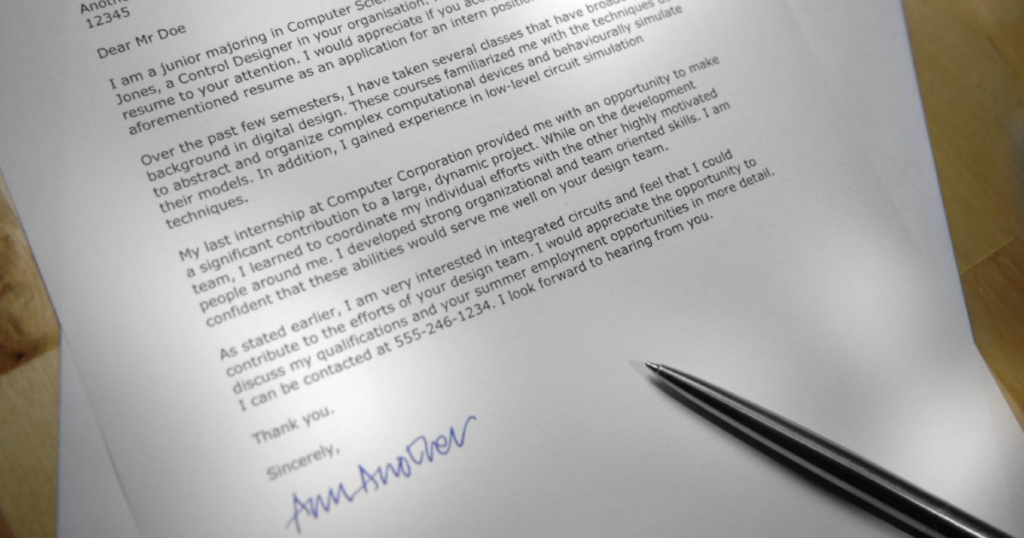
Free, professionally-designed cover letter templates for you to customise and use at will. Each cover letter template is designed to make a lasting impression with the recruiters and hiring managers. Elaborate your story on a beautifully designed cover letter. Stand out from the crowd, get noticed, and get hired with our free cover letter templates.
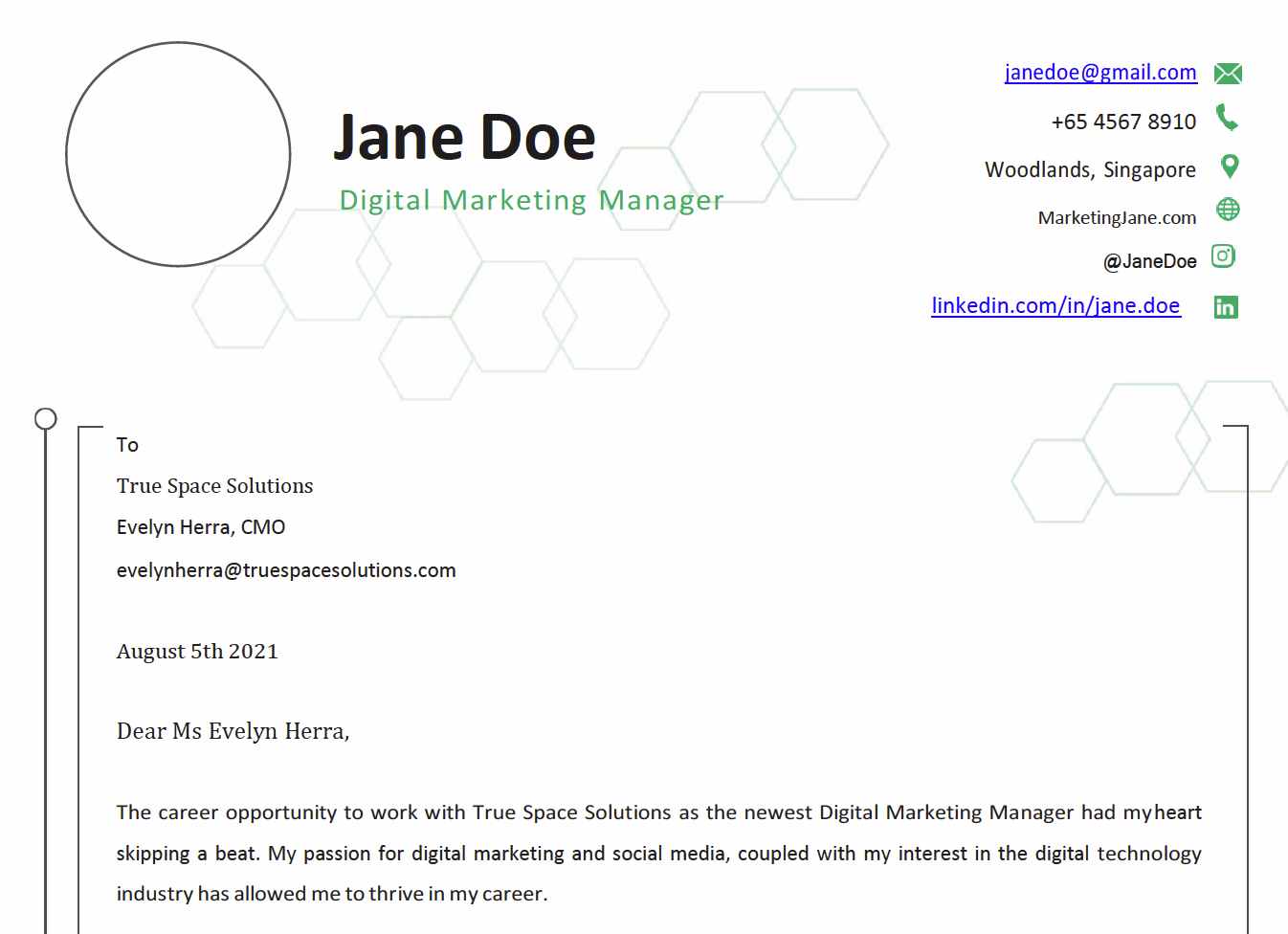
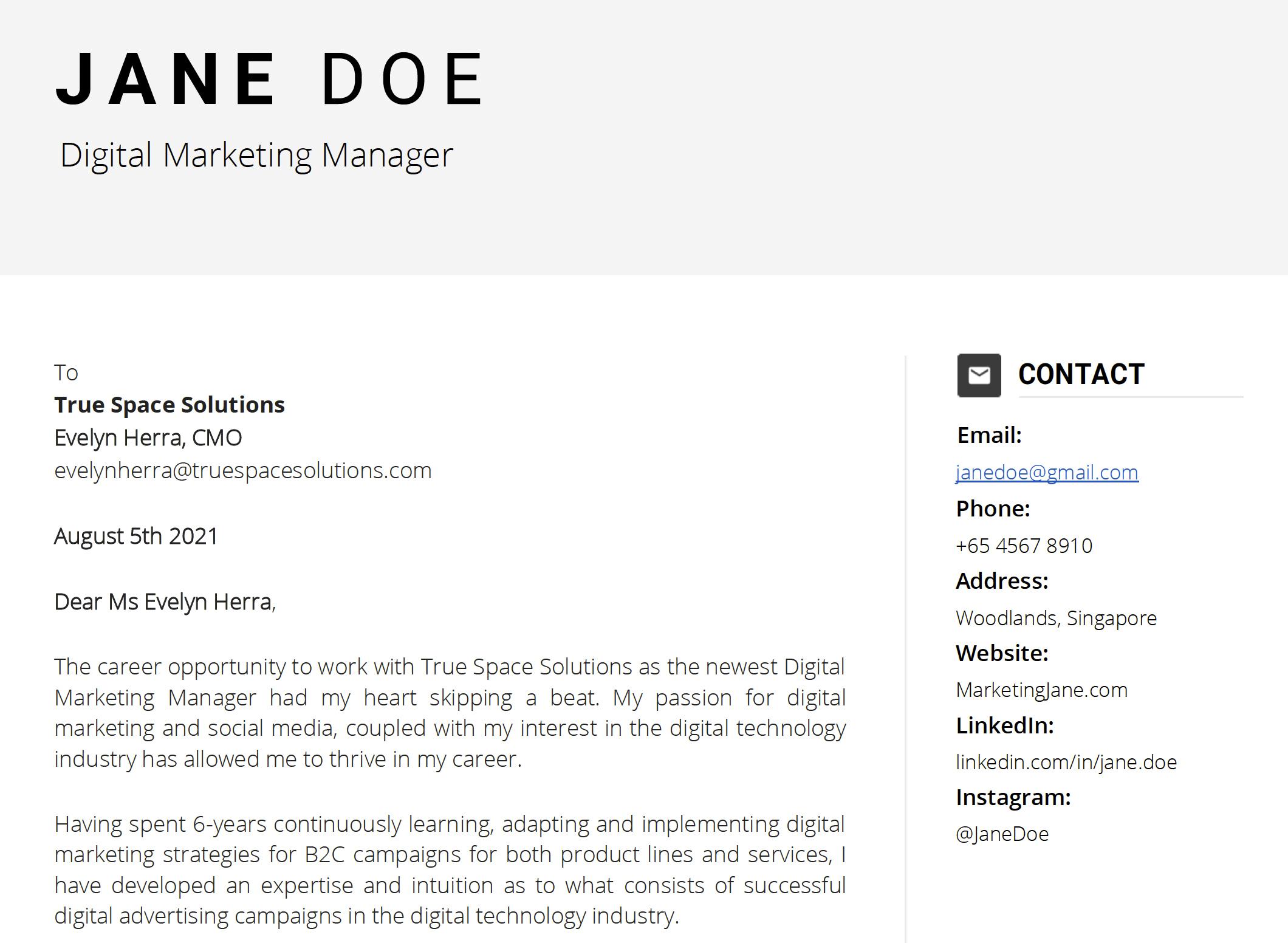
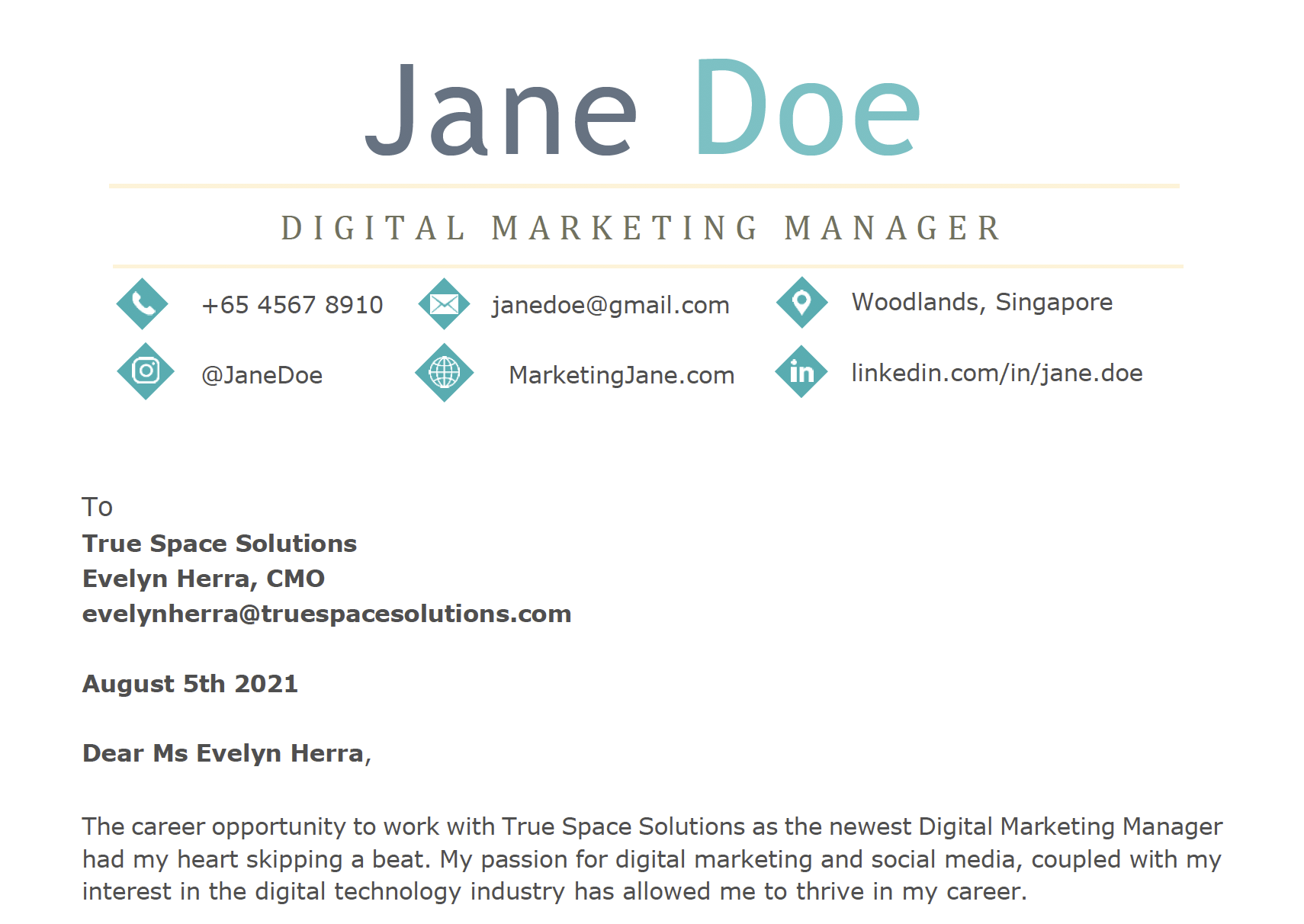
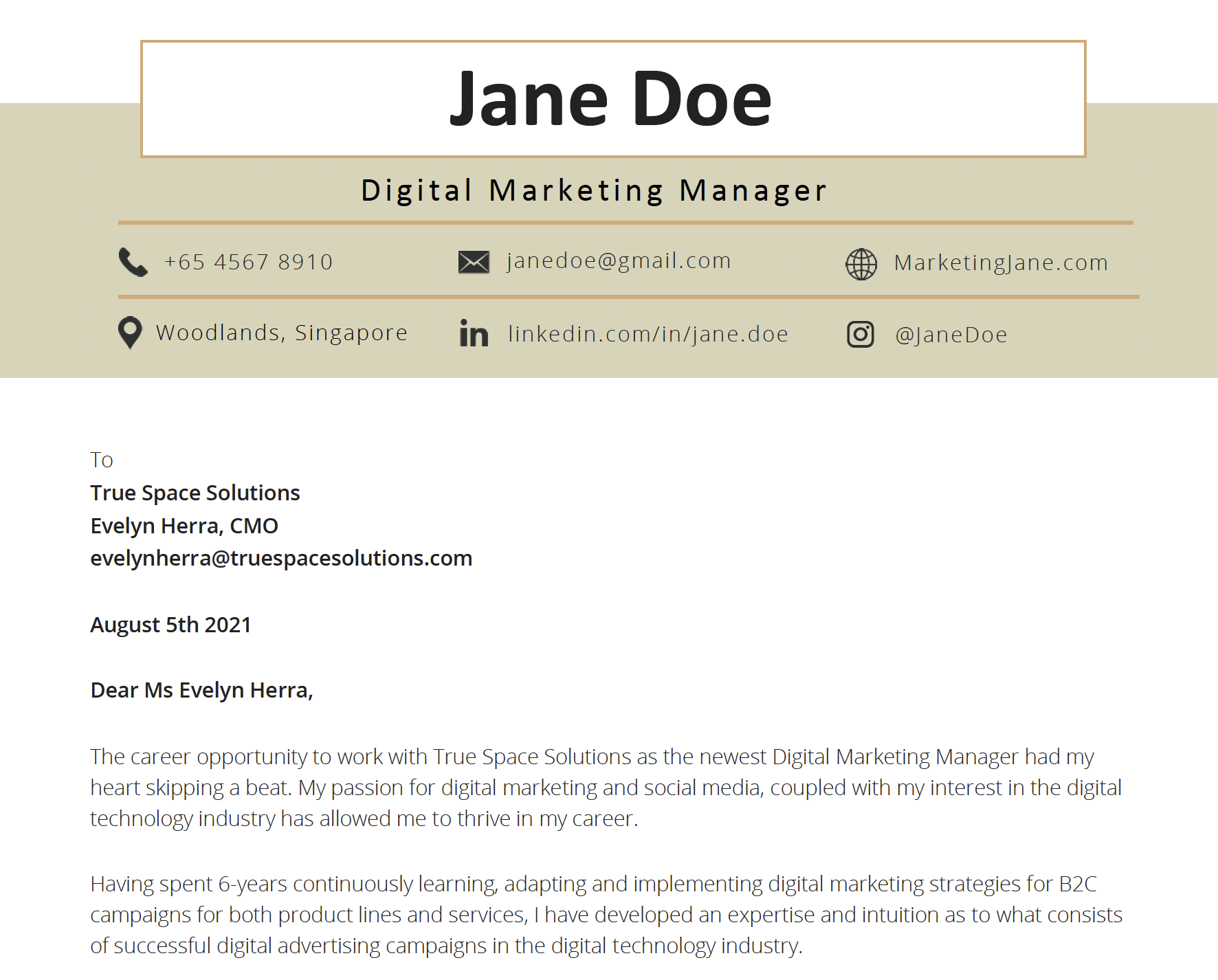
A cover letter is an ideal companion to your resume or CV. It’s a one-page letter with a compelling story of your career, discussing only your highest achievements. Put your best foot forward with a cover letter that sparks the interest of potential employers.
You’ll want to write a new tailored cover letter for every job you apply for, highlighting not only your interest but why you are the ideal candidate for the role and the company. Note that a cover letter should never repeat what’s listed on your resume or CV, but instead expand on them and other areas of your career that have contributed to your accomplishments.
A cover letter is essentially a well-formatted formal one-page essay written with the intention to wow the reader and have them curious about how you can help their organization with the experiences you possess.
A cover letter is personal, and so make sure to use this as a guide. Include as many or as few paragraphs within the perimeters of one page with clean margins and spaces. But sticking to this outline will ensure a well-received cover letter.
Resumes and CVs are a completely different ball game compared to a cover letter. You may interchange or use a few of the same tips and tricks between a resume and CV, but a cover letter requires a set of different tips.
Yes, good grammar and spelling are essential when writing a cover letter. This means unlike with a resume or a CV, you’ll want to include the “I” where applicable to you speaking about yourself.
Make sure sentences flow, and the two best ways to ensure that are to read the cover letter out loud or ask someone to read and edit accordingly. Your sentences should not be very long or sound too formal and stiff. There should be a hint of personality, especially at the very beginning.
One similarity across the board between resumes, CVs and cover letters are tips and tricks to using action words. These powerhouse words can make the biggest difference when used right with thought behind them.
Action words are adjectives, used to describe. In terms of cover letters these words create an impact and pull readers into the subject at hand. Now, this doesn’t mean you should pull up a thesaurus and use the most spectacular sounding words. Sometimes using simple action words can have just as much of an effect as a bombastic action word.
For example, a simple action word would be helped, and the more enthusiastic action word would be strengthened. Both are great, and depending on the sentence one or the other can be used just the same without worrying about sounding too simple or too over the top.
An outline is always helpful when writing a cover letter, making sure you have a clear coherent message. List out the accomplishments and points you’d like to expand upon in a flow that makes sense.
Have several outlines ready for the different cover letters you’ll write for the different open roles you want to apply for. You’ll save time down the road by doing this.
Don’t include anything about your previous salary or what your salary expectations are for this role. This is a verbal discussion that should only be had during an interview.
Reserve all questions and inquiries in a separate email from that of your application or ask them at the end of the interview.
As mentioned before, avoid repeating points and sentences from your resume or CV. Instead, you should reference the points you want to highlight from your resume and CV in a natural way in your cover letter.
Images are unnecessary for almost every job out there unless you’re an actor, singer or model. In that case, a cover letter won’t do you any good. Understanding what is required and the role of a cover letter will help you plan exactly what and how to make an impression on a potential employer. Just remember to stick to a simple one-page format and never repeat points from a resume or CV, instead learn to expand on the important points mentioned in your resume or CV.